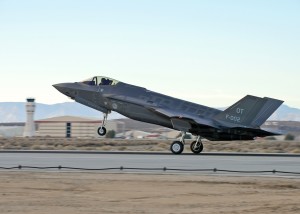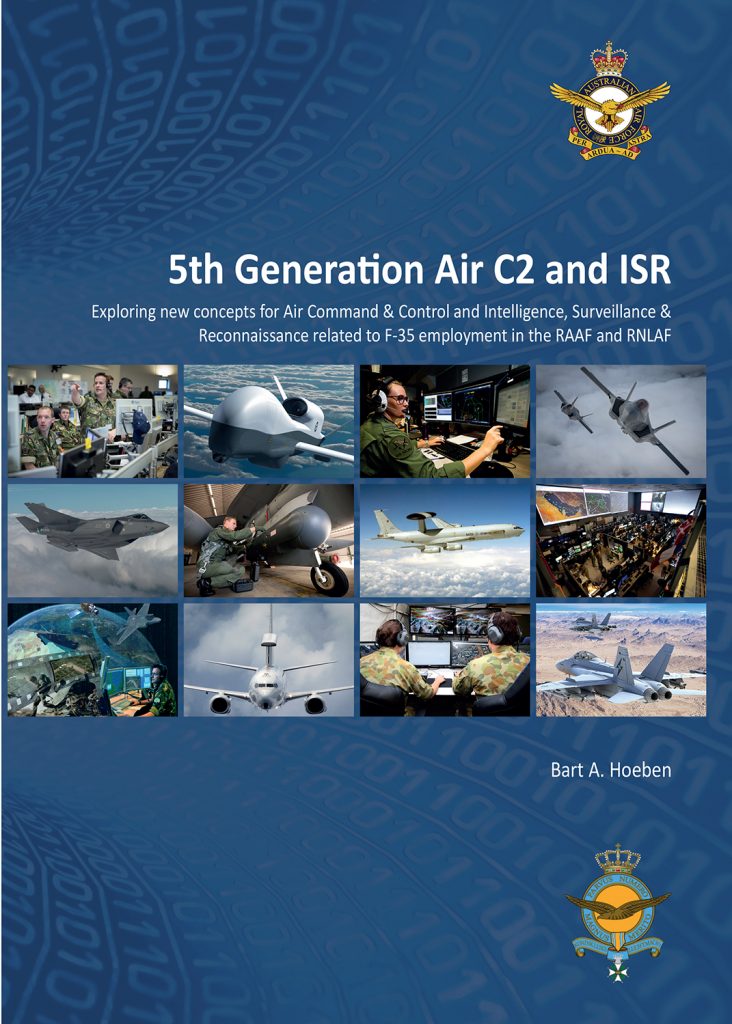2018-01-15 The title of a new report issued by our partner the Air Power Development Centre of the Royal Australian Air Force is entitled 5th Generation Air C2 and ISR.
A key aspect of the F-35 global enterprise is that air warriors are working throughout the enterprise to reshape air operations.
This paper is a core example of the kind of thinking going on in the enterprise.
The paper is written by a Dutch Air Force officer during his time in Australia.
The author is Lt. Col. Bart Hoeben of the Royal Netherlands Air Force.
Lieutenant-Colonel Bart Hoeben was born 3 March 1965. He joined the Netherlands Royal Air Force at age 21. After five years of military training and academic studies at the Royal Military Academy, Bart received his officer’s commission in 1991. After training as a Fighter Controller and Air Battle Manager, Bart spent the first part of his career serving in Air Command and Control positions in The Netherlands and Germany, including a four-year tour on NATO AWACS. He was deployed several times for NATO peace-keeping and peace-enforcing operations.
In 2007 Bart moved to Washington DC, to work in the F-35 Joint Program Office in the Interoperability Integrated Product Team. After returning to The Netherlands in 2009, Bart was assigned to a Joint Intelligence Surveillance and Reconnaissance requirements position in the Ministry of Defence. After a year of study at the Netherlands Defence College from 2012 to 2013, he returned to the Ministry of Defence to work as a Senior Staff Advisor in Unmanned Aircraft Systems, Space and Air Operations Control. In 2016, Bart filled the position of International Fellow at the Royal Australian Air Force Air Power Development Centre in Canberra, Australia.
In his paper, Lt. Col. Hoeben looks at the co-evolution of C2, ISR and the coming of the F-35 as a fleet air combat asset.
“The goal of 5th Generation Air C2 and ISR is to adjust military actions better as the situation unfolds and thus reach better and quicker effects and objectives…..”
He then cited another work where the authors “make the case that traditional command and control approaches lack the agility required for 21st century missions, that are simultaneously more complex and more dynamic. These authors conclude that C2 approaches that are agile and take full advantage of all the available information and assets, are better suited.
In their research they define three key factors that can be thought of as the dimensions of a C2 approach towards an edge (agile) organisation (see Figure 3). These dimensions are:
• Allocation of decision rights
• Distribution of information
• Patterns of interaction among the actors…
He then noted that although these authors “….take a slightly different approach through this decomposition of C2, they implicitly acknowledge the importance of new (Air) C2 and ISR concepts to achieve a higher degree of agility. After all, the fundamental function of ISR is to distribute information (‘getting the right information and intelligence, to the right people, in the right format, at the right time’13) and Air C2 is predominately about making decisions. By adding patterns of interaction among actors as the third dimension, they stipulate the importance of collaboration.
 “This decomposition gives an opening to explore the utility of current and new systems (including the F-35) and processes for distribution of information (ISR) and their ability to collaborate with each other.
“This decomposition gives an opening to explore the utility of current and new systems (including the F-35) and processes for distribution of information (ISR) and their ability to collaborate with each other.
“Furthermore, decomposing (Air) C2…, gives opening for a discussion on allocation of decision rights that is relevant in relation to the introduction of the F-35. The F-35 will supply pilots with an, until now, unprecedented situational awareness through the use of on-board ISR capabilities (sensors).
“This leads to a greater ability to adjust actions upon the situation as it unfolds.
“In order to capitalise on this ability, F-35 may require more freedom to act. In other words, allocation of more decision rights at the tactical (F-35) edge may be required to enhance operational agility.”
The Lt. Col. adds argues that “the first 5th Generation aircraft by RAAF and RNLAF does bring unprecedented opportunities for situational awareness and the application of 5th Generation concepts for Air C2 and ISR. Together with the introduction of F-35, these concepts may very well become essential stepping stones towards creating a 5th Generation Air Force.”
One could argue that for the smaller allied air forces, the F-35 will be leveraged as a core ISR/C2 aircraft in ways that the larger USAF will not.
But this also means that the allies in the global enterprise may well drive innovation in ways the USAF might not as well, which provides a significant cross-learning opportunity.
The executive summary of the paper is as follows:
In future conflict, we may end up having to fight a peer adversary.
In such a fight, we will not have a decisive technology advantage.
Furthermore, it is likely that we will be physically outnumbered.
In that fight, the way we orchestrate our force will be vital in gaining us the advantage and ultimately to win the conflict.
Air Command and Control (Air C2) is all about orchestrating our Air Forces.
Through exercising Air C2, we strive for decision superiority.
A major stepping stone towards achieving decision superiority is achieving information superiority. Intelligence, Surveillance and Reconnaissance (ISR) aims at just that.
The future operation environment in which we fight a peer adversary has the potential to become very complex and highly dynamic. In that environment, we need to be able to adjust our actions constantly to cope with any situation that may develop and react in real-time to emerging threats and opportunities.
We need to be agile; ready to resort to high degree of dynamic (re-)tasking to out-pace and out-manoeuvre the adversary.
This puts extraordinary strain on the real-time link between Air C2 and ISR to achieve and maintain decision superiority.
Both the RAAF and the RNLAF will significantly transform during the next decade, as captured in Plan Jericho and CLSK 3.0.1
 Two F-35 Lightning IIs, F-001 and F-002, of the Royal Netherlands Air Force landed at Edwards Jan. 16, 2015 after a five-hour flight from Eglin Air Force Base, Fla. The Joint Strike Fighters arrived for an operational test and evaluation phase here in the High Desert. (U.S. Air Force photo by Jet Fabara)
Two F-35 Lightning IIs, F-001 and F-002, of the Royal Netherlands Air Force landed at Edwards Jan. 16, 2015 after a five-hour flight from Eglin Air Force Base, Fla. The Joint Strike Fighters arrived for an operational test and evaluation phase here in the High Desert. (U.S. Air Force photo by Jet Fabara)
One of the driving factors for the transformation is the introduction of the F-35 Lightning II. To employ it effectively and efficiently,
RAAF and RNLAF will have to look critically at how we operate, and probably apply new concepts.
Both Forces have a vested interest in understanding how current and planned Air C2 and ISR systems and concepts support exploiting the RAAF and RNLAF combat potential to the max.
They furthermore share the interest in evolving Air C2 and ISR to suit F-35 employment in a future, 5th Generation Air Force to achieve the required agility to operations at the tactical, operational and strategic level. This paper explores these new concepts for Air C2 and ISR related to F-35 employment.
The paper provides tangible recommendations about improving Air C2 and ISR systems, their integration, collaboration and Information & Communication Technology (ICT) at the tactical level, including the possible application of a combat cloud, and towards F-35 employment and follow-on development.
It furthermore explores the possibility for distribution of control towards the tactical edge, concluding that RAAF and RNLAF should further pursue this concept.
The paper also looks at command and ISR at the operational level and strategic employment of F-35 and draws two conclusions: first, that new concepts for Air C2 and ISR related to F-35 employment deserve increased attention from RAAF and RNLAF, and second, that successfully employing F-35 requires strong(er) influence of RAAF and RNLAF at the operational and strategic level.
Overall, the paper recommends possible ways in which RAAF and RNLAF could cooperate to face the Air C2 and ISR challenges and opportunities that come with the transition to a 5th Generation Air Force. This could involve stimulation and facilitating international discussion on new concepts for Air C2 and ISR.
The paper provides a framework for 5th Generation Air C2 and ISR, which illustrates the importance of coherence among Air C2, ISR, collaboration and ICT when formulating requirements for system improvements, tied to enhancing Air C2 – ISR integration at the tactical level.
It can also be used as a framework to further discuss the new concepts for Air C2 and ISR related to F-35 employment. Furthermore, the framework supports a broader view of these concepts, including the required professional mastery, collaboration and ICT.
Hence, it could also be used as a point of departure for further Air C2 and ISR analysis and concept development to support the transformation towards a 5th Generation Air Force.
Editor’s Note: For an opportunity to read the complete paper, please go to the following:



